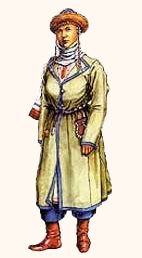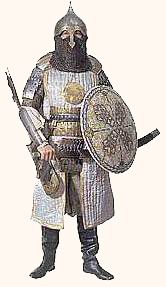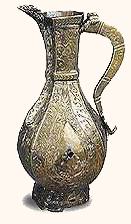Tatar National Traditions, Culture and Art
 | |
| Minaret of Bournaevskaya Mosque |
Combination of at least four types of cultural interaction (Turkic, Finno-Ugric, Bulgarian and Slavonic-Russian) and two religions (Islam and Christianity) account for unique features of this locality, originality of art, cultural and historical values.
The life of our ancestors, national features, beauty ideal and religion, changes in socioeconomic conditions and contacts with other nations were mirrored in national art and cultural heritage.
When it comes to historical heritage and culture, we should remember that along with common cultural traditions, there are different ethnic groups of the Tatars with their inherent features. And Kazan was a spiritual center of the main ethnic group of the Tatars - the Kazan Tatars, which became a basis of forming the Tatar nation.
HISTORICAL ASPECTS
 | |
| Bulgarian Woman VIII-IX |
 | |
| Soldier's Costume The Golden Horde XIV |
The Volga Bulgaria town-planning traditions were developed. Travellers and rich merchants, diplomats and politicians were amazed at the beauty of majestic khan's palaces, cathedral mosques with high minarets, mausoleums decorated with white and light-blue tiles, glass glaze and gold leaves. The city of Bulgar in the 13-14th centuries appeared to be a huge town-planning complex. The area of the second-largest city of Bulgaria - Bilyar was 530 hectares. (At that time Kiev occupied 150, Paris - 439.)
 | |
| Black Palace XIV |
In the second half of the 16th century, the Kazan Khanate joins the Russian state. Arriving in Kazan, migrants from Moscow, Novgorod, Pskov and other Russian cities introduce some elements of Russian culture, which, in turn, had not escaped the influence of Eastern culture. This became apparent in altered church architecture (decorative methods, oriental ornamentation), appearance of magnificent oriental design, polychromy which were unusual in Russian art, however, took roots in it through borrowing the art patterns of Tatar culture. Thus, the eight-minareted cathedral mosque Kul-Sharif, destroyed in the Kazan Kremlin in 1552, according to the assumption of historian M.Hudyakov, served as a prototype of the Moscow St.Basil's Cathedral in Red Square. The ninth central dome of this cathedral, towering the other eight, personified victory of the cross over the crescent. The cathedral had no analogues in Russian architecture of that time, but had much in common with oriental architecture.
 | |
| Petropavlovsky Cathedral |
 | |
| Kazan Cap |
as well as the khan's throne brought from Kazan by Ivan the Terrible, known as Boris Godunov's throne, are stored in the Moscow Armory Museum.
Tatar influence evolved in everyday-life culture as well. It concerns Turkic names of certain objects of clothing, trade and household. Many famous Russian names are of Tatar origin: Aksakov, Derzhavin, Karamzin, Turgenev.
The Russians also acquired some bases of state culture from the Tatars. Population was registered by means of census, a harmonious system of taxes and duties appeared.
These are the evidences of a close interaction between the cultures of Moscow, Bulgar and Golden Horde states, and later the Kazan Khanate, which traded, waged wars, and exchanged skilful craftsmen and architects.
 | |
| Jug with the Arabic Inscription |
Today original traditions of the Tatar national arts acquire a special artistic significance. Owing to research works and expeditions, the collections of Kazan and other museums are enriched with exhibits of cultural and historical value. As a form of the national arts, there is a manufacture of mosaic footwear (Arsk Association) and artistic weaving (Alekseyevsk Factory). Studying national artworks, modern artists create jewelry employing filigree technique, embroidered table-clothes and towels, incrusted leather footwear, national souvenirs and memorable gifts.